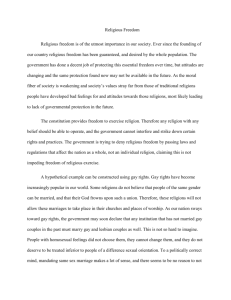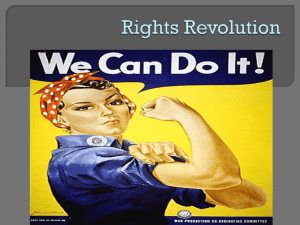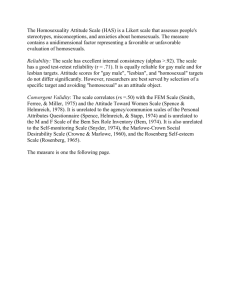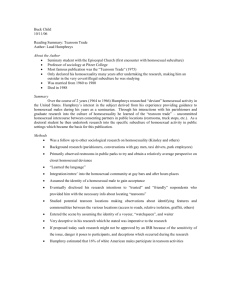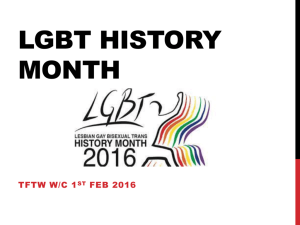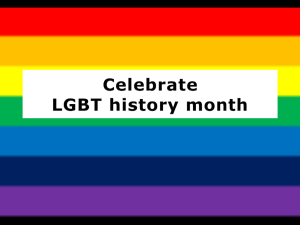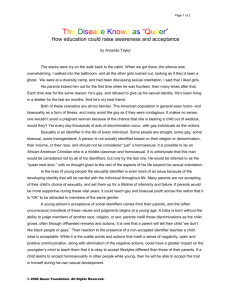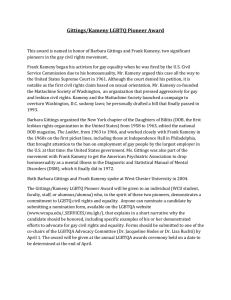Sonja Kovalevsky
advertisement
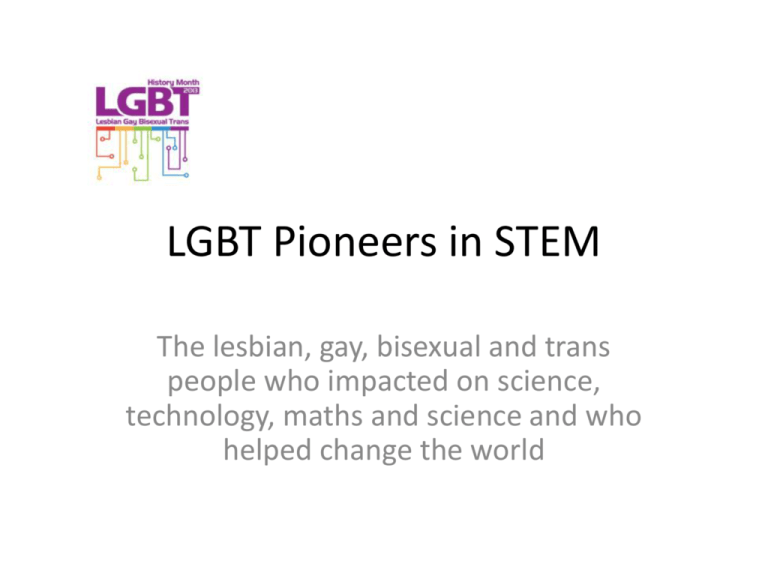
LGBT Pioneers in STEM The lesbian, gay, bisexual and trans people who impacted on science, technology, maths and science and who helped change the world Magnus Hirshfeld Physician, sex researcher, and early gay rights advocate Hirschfeld developed the theory of a third, "intermediate sex" between men and women. He sought to use science as a weapon to fight for gay rights. He founded the Institute for Sexual Research which was destroyed by the Nazi. Alan Turing Mathematician, logician and cryptographer Turing is considered to be the father of modern computer science. During the war he worked at Bletchley Park. His career came to an end when he was found guilty of homosexual activities and subjected to hormonal treatment. Karl Heinrich Ulrichs Pioneer activist Ulrichs is considered to the the first person to have come out publicly (1867). He is the author of The Riddle of Man-Manly Love which exposes his theories on sexuality. He coined the term Uranian to describe homosexual men. George Washington Carver Scientist Carver’s studies and teaching revolutionized agriculture in the Southern part of the US. Much of his fame is based on his research and promotion of alternative crops to cotton, such as peanuts and sweet potatoes. Leonardo da Vinci Genius Da Vinci was a truly multitalented man: scientist, mathematician, engineer, inventor, anatomist, painter, sculptor, architect, botanist, musician, poet and writer. Barbara Burford Barbara joined the NHS in 1964, specialising in electron microscopy in postgraduate teaching hospitals, before leading a team at the Institute of Child Health and Great Ormond Street Hospital for Children. She ran the pulmonary vascular laboratory there for several years during the 1980s. Working with Sheila Haworth, her team was central to several breakthroughs in heart and lung transplant surgery for infants and children. During her years in London, Barbara was active in feminist politics and wrote plays, poetry, short stories and a novella. Her play Patterns was produced at the Drill Hall theatre in 1984. In the same year her poetry featured in A Dangerous Knowing – Four Black Women Poets. In 1986 she published The Threshing Floor, a novella and collection of short stories that has since become a staple of school and college reading lists. Barbara moved to Leeds in 1990 to set up IT systems for the NHS executive. A key achievement was Positively Diverse – a programme of guidelines designed to help achieve equality in the NHS. The accompanying field book is still being used by organisations across the country. Jane Icenogle After Lucent software engineer Jane Icenogle came out to coworkers, her productivity went up and she felt more a part of the team. Ben Barres M.D., Ph.D American neurobiologist who teaches at Stanford university. His research focuses on the interaction between neurons and glial cells in the nervous system. He is currently Chair of the Neurobiology department Barres, a transexual man who transitioned in 1997 made headlines in the mainstream press in July 2006 after writing an article in Nature that addressed issues of sex and intelligence.. Dr. Donna Riley Associate Professor of Engineering at Smith College Dr. Riley is out in articles on her experiences as a woman in engineering as well as in work on engineering education. In her teaching, Dr. Riley employs liberative pedagogies - that is, feminist, critical, and queer pedagogies that seek to empower students as scholars and as whole people by turning a focus to power relations in the classroom, as well as in the larger world. Sir Francis Bacon - 17th century English philosopher of science, author of Novum Organum; called “the high priest of modern science” for elucidating principles of the scientific method. Bacon was well known during his lifetime as a homosexual, and good friend of the homosexual English King, James I. At one point, it is told, Bacon’s mother criticized him for inviting his young latin lover, Antonio Perez, home to live. She ordered “that bloody Perez and bed-companion of my son” out of the house. Source: Jonathan to Gideon, The Homosexual in History, N.I. Gard Vantage Press, NY, 1964 S. Josephine Baker 1873-1945 Physician Organized the first child hygiene department under government control in New York City. Her tenure led to the lowest infant death rate in any American or European city during the 1910’s. Baker was a consultant to many child care organizations, and the president of several child health professional societies. Personal encounters with Baker and her companion, Louise Pearce, are described in A.R. Wylie’s autobiography. Baker and Wylie shared a New York apartment together, and eventually a house in Princeton where they were joined by Pearce. Source: The Gay 100, Paul Russell, Citadel Press, Carol Publishing Group, NY, 1994 Allan Cox - 20th century American Geophysicist 20th century American Geophysicist, specialist in paleomagnetism, and author of two well-know books on plate tectonics. Cox, originally a chemistry major as an undergraduate, discovered he had an instinctive eye for geology while performing summer field studies with his mentor and (future) lover Clyde Wahrhaftig. Cox and his colleagues developed a calendar showing the complicated and irregular schedule of polarity changes in the earth’s past, and discovered evidence of plate tectonics. His work brought him many honors, including election to the National Academy of Sciences, and the American Geophysical Union’s Fleming medal. Source: www.agu.org/inside/awards/cox.html; Clyde Wahrhaftig, address to FLAG, 1990 Neil Divine - 20th century American Astrophysicist Major contributor to modern theory of star formation and prediction of meteoroid and space debris environments. During his 25 years at Caltech’s Jet Propulsion laboratory, Neil made many fundamental scientific contributions, including defining the radiation belts around Jupiter, Saturn, Neptune, and Uranus, and the dust environment around Halley and other cometary targets. During his tenure at JPL, he often served as a mentor and inspiration to many younger space physicists who benefited from both his scientific incisiveness and quick wit. Devine died in 1994 from complications from AIDS, shortly after celebrating his 55th birthday. Source: Devine’s memorial biography, 1994 Frank Kameny May 21, 1925 – October 11, 2011 Astronomer, Activist, and Organizer Dr. Kameny matched Margaret Mead’s declaration that "injustice, experienced in the flesh, is the thing out of which change explodes." After a year teaching at Georgetown University, he obtained a civil service job with the U.S. Army Map Service in July 1957. Soon an investigator from the Civil Service Commission came to question him about reports that he was a homosexual. That fall he was fired. Then, in January 1958, he was barred forever from federal government employment. Frank Kameny decided to sue. He lost. So he appealed. Again he lost. Even his lawyer deserted him, but Frank continued on, asking the Supreme Court of the United States to direct that the case be reconsidered. In March 1961, the Supreme Court denied his petition. Having failed to achieve his goal as an individual, Frank decided it was time to organize. The Man who Wouldn’t Wait for Stonewall Since there weren’t any gay rights organizations in Washington, D.C., for Frank Kameny to turn to, he decided to start one of his own. Although Stonewall was still eight years away, "homosexual rights organizations" were not unknown. In 1948, Henry Hay had founded the "Bachelors for Henry Wallace" (a liberal Democrat running for the Presidential nomination), and two years later Hay founded the Mattachine Society of Los Angeles. Sally Ride 1951 - 2012 American physicist and astronaut. Ride joined NASA in 1978, and in 1983 became famous as the first American woman to enter space, part of the crew of the space shuttle Challenger. As of 2012, Ride also remains the youngest American astronaut to be launched into space at the age of 32. In 1987, she left NASA to work at Stanford University . She cared deeply about the nation's space program and devoted her post-NASA career to keeping middle-school kids -- especially girls -- hooked on science, math, technology and engineering. Bruce Voeller 1934 –1994 20th century American biologist and AIDS researcher who pioneered the use of nonoxynol-9 as a spermacide and topical virustransmission preventative. A prominent gay rights activist, Voeller cofounded the National Gay Task Force, and served as its executive director for 5 years. He established the Mariposa foundation, to conduct human sexuality research, placing special emphasis on reducing the risks of sexually transmitted diseases. At the time of his death, Voeller’s research centered on the reliability of various brands of condoms in preventing the spread of diseases., and on viral leakage studies for the (then) recently approved “female” condom. Source: New York Times Obituaries, 1994 Alexander von Humboldt 1769 – 1859. 19th century Prussian naturalist explorer of Central and South America, author of a 23-volume work on his travels, and of the seminal Cosmos, which laid the foundations for modern physical geography and meteorology. Humboldt was a leading European figure of his day, considered second only to Napoleon in influence. A major Pacific current, numerous cities, counties, and other landmarks bear his name. Following a passionate two-year affair with a Prussian soldier (von Haeften), Humboldt lived with von Haeften and his wife during the first six months of their marriage. He had a close relationship with Bonpland, the French botanist who accompanied him on his travels to South America, and described with attentive detail the masculine beauty of South American Indians. Humboldt’s homosexuality was widely acknowledged during his lifetime. Upon his death, Humboldt left everything to his manservant, Siefert; his sister burned Humboldt’s love letters. Source: The Humboldt Society lecture, Philadelphia, 1996 Sonja Kovalevsky 1850-1891 19th century Russian mathematician Sonja Kovalevsky - 19th century Russian mathematician, developed Kovalevsky’s theorem, editor of Acta Mathematica. Showing aptitude in mathematics at an early age, Kovalevsky is an example of a brilliant woman that encountered ridiculous barriers solely because of her gender. Women were not allowed to study in Russian universities, and her father considered it improper for her to study abroad. Kovalevsky entered a marriage of convenience and went to Germany to study with Karl Weierstrass. For her 1888 work “on the Problem of the rotation of a solid Body about a Fixed Point”, she was awarded the famous Prix Bordin of the French Academy of Sciences. Source: amazoncity.com Museum of Women in Science and Technology Margaret Mead 1901 1978 20th century American anthropologist and psychologist Author of Coming of Age in Samoa, and Curator of Ethnology at the American Museum of Natural History. While President of the American Association for the Advancement of Science in 1977 she presided over the passage of a AAAS policy statement deploring discrimination against gay and lesbian scientists. Mead had significant sexual affairs with other women during her married lifetime, and helped pioneer, through cross-cultural studies, greater understanding for the natural variety of sexual behaviors that occur in human societies. Source: Margaret Mead: A Life, J. Howard, Simon and Schuster, NY, 1984 Florence Nightingale 1820-1910 century British Nurse Organized the world’s first school for nurses, expert and reformer for hospital hygiene, sewage treatment, and regularized medical practices. She became the first woman ever to be awarded the Order of Merit by the British government. Although there is no specific documentation that Nightingale had physical homosexual relationships, she shared her emotional life primarily with other women, and adamantly rejected any offer of marriage that came her way. Nightingale played a vital role in the opening up of legitimate careers for women outside the home and, in this way, helped create the social and economic conditions that made the modern lesbian (and heterosexual working woman) possible. Source: The Gay 100, Paul Russell, Source: The Gay 100, Paul Russell, Citadel Press, Carol Publishing Group, NY, 1994 Louise Pearce - 1885 – 1959 Pathologist at the Rockefeller Institute Rockefeller Institute who helped develop a treatment for African sleeping sickness (trypanosomiasis). She, along with fellow pathologist Wade Hampton Brown, and two chemists, developed tryparsamide. The Rockefeller Institute sent Pearce to the Belgium Congo in 1920 “trusting her vigorous personality to carry out an assignment none to easy for a woman physician and not without its dangers”. For her service, Pearce received the order of the Crown of Belgium, and in 1953, the Royal Order of the Lion. Pearce also studied syphilis, for which tryparsamide was standard treatment until penicillin replaced it. With Brown, she discovered and developed the Brown-Pearce tumor, systematically studied syphilis in rabbits, explored how a virus might spread cancer, and researched immune reactions to rabbit pox. Source: The History of the Rockefeller Institute, 1901-1953, G.W. Corner, Rockefeller Institute Press, NY, Jim Pollack 1938 -1994 American astrophysicist Astrophysicist, senior space research scientist at NASA Ames Research Center. Pollack was a world-renowned expert in the study of planetary atmospheres and particulates whose work led to many advances in our understanding of the solar system. He and Carl Sagan postulated (correctly) that the seasonal color variations on mars were caused by wind storms and dust, rather than plant life. He specialized in evolutionary climate change of terrestrial planets, and evolution of the giant gas planets. He participated in every major NASA flight mission since Apollo. Source: Carl Sagan, A Life, Keay Davidson, John Wiley & Sons, 1999 Clyde Wahrhaftig - 1919-1994 American Geologist and Environmentalist Author of Streetcar to Subduction, a geological tour of San Francisco via bus and streetcar, recipient of the Geological Society of America’s Kirk Bryan Award for Geomorphology. Wahrhaftig was a versatile geologist who made notable contributions to understanding the coal deposits, geology and glaciers of Alaska and the landforms, surficial deposits and and bedrock geology of the Sierra Nevada and the California Coast Ranges. A homosexual all his life who had a long relationship with geologist Allan Cox, Wahrhaftig took the opportunity to “come out” during his acceptance speech for the Geological Society of America’s Distinguished Career Award. In accepting that award, Wahrhaftig made a plea to his fellow scientists to accept homosexual students without bias and encourage them to enter the field of geoscience. Source: of geoscience. Source: USGS Public Affairs Office press release, 1994 Professor Lyn Conway American computer scientist, electrical engineer inventor trans woman and activist for the transgender community. Conway is notable for a number of pioneering achievements, including the Mead & Conway revolution in VLSI design, which incubated an emerging electronic design automation industry. She worked at IBM in the 1960s and is credited with the invention of generalised dynamic instruction handling, a key advance used in out or order execution, used by most modern computer processors to improve performance Our Aims To change the curriculum and culture of our schools in order to: • make schools safe and comfortable places for all pupils and educators who use them • to provide an appropriate education for all our students • Make LGBT people visible and safe
